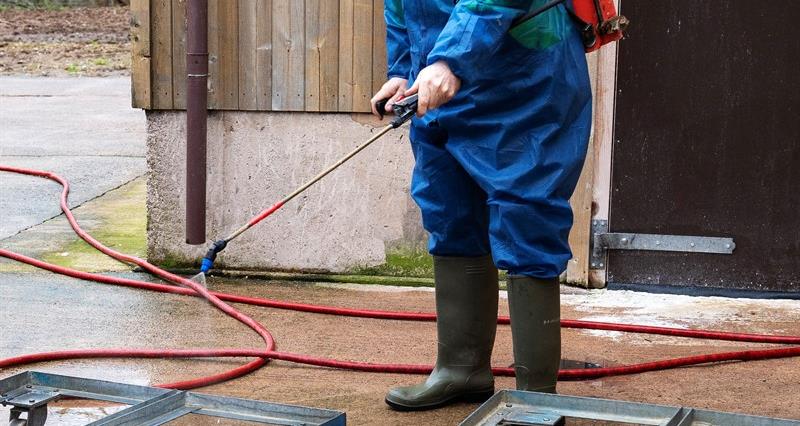Need-to-know issues for planning for Avian Influenza C&D
There are a number of areas which you must consider in order to avoid delays or complete blockers when completing your secondary C&D plan. Use this list to guide you through the process.
Know your buildings
- What are your buildings made from? Asbestos and fibreboard building materials cannot be effectively cleaned without safety risks. It is likely to be uneconomical to remove asbestos, replace and then C&D the building.
- Do your buildings have maintenance issues? If walls, ceilings and floors are damaged, these must be repaired or replaced before C&D can be completed as buildings are likely to be re-contaminated. These are best repaired or replaced before an outbreak is experienced. Drainage issues must also be addressed before C&D can begin.
Know your premises
- Do you have co-located businesses which would be impacted by movement and access restrictions? This can include everything from other types of livestock farming to equestrian businesses and farm shops. Best practice would be to segregate the site before an outbreak so that they may be considered separate epidemiological units.
- Consider whether an additional CPH may be appropriate? Certain criteria must be met to justify the separation of holdings, including separate entry and exit points. If granted, it can assist segregation of the site and business continuity.
- Is your entry on the national poultry register accurate? The number and type of birds must be accurate to avoid delays and potentially further sanctions.
- Do you have a site plan/map? This should include a plan of buildings, but also wider premises/land, including entry points, people and animal flows.
Inter/intra site biosecurity
- Do you share equipment (including clothing and footwear) between buildings or sites? Doing so significantly increases your risk of introducing avian influenza to your flock, if it is circulating in wild birds which live on and around your premises. Additionally, if you experience an outbreak on your premises, you are much more likely to spread it to other buildings.
- What are your biosecurity procedures for moving people and equipment between buildings or sites? Wherever possible, this should be entirely avoided or at least kept to a minimum. If not achievable, thorough barrier C&D of equipment and people should occur every time an item is moved between buildings or sites.
Know your area
- What other agricultural/poultry/food businesses are in your area? Consider what businesses are within 3km or 10km of your premises. They could increase your biosecurity risks or impact your businesses through restrictions and visa versa.
- What environmental/geographical considerations might impact your C&D plan or restrictions? Water drainage/catchment from your premises could impact your C&D plans. The presence of a public road could impact your biosecurity arrangements.
Waste disposal
- Do you have capacity for storing wash water and slurry (prior to separation)? Containers or lagoons must be secure and sufficient for thousands of litres of liquid. Buying or securing the use of IBC or large tanks are an essential component of business preparedness.
- What uncovered bedding would you lose in an outbreak? This includes stored bedding (or feed) for other purposes (e.g. equine or livestock business) – you may lose all your stores of bedding and feed immediately in the event of an outbreak. All bedding which is not individually wrapped cannot be safely cleansed and disinfected, and must be disposed of as contaminated waste. Clean bedding may be used to soak up wash water then be treated as muck for disposal.
- Do you have a suitable place for a muck midden/compost heap/burial pit? Middens and compost heaps must be bunded; they and burial pits must be sited away from drainage into watercourses.
Know your chemicals
- Do you use Defra-approved disinfectants at correct concentrations? The Defra-approved list of disinfectants and concentrations are listed here. Check that you have sufficient stores available and that you are using it at the correct concentration for Avian Influenza. Accuracy of dosing and application is an essential component of pre-outbreak biosecurity and for effective C&D, so good equipment is needed.
- Do you have chemical safety and COSHH risk assessments to hand? These are a requirement for health and safety during all chemical use but are an essential part of preparing a C&D plan. They can be obtained from your chemical supplier or wholesaler.
Know your processes
- Do you have established C&D processes for your premises? If not, now is the time to think about what they should be, familiarise yourself with writing a C&D plan and execute turn-around C&D/good biosecurity practices wherever possible. These will improve your biosecurity measures overall and reduce the impact should the worst happen.
- Can you save time and resources by using your existing turn around C&D as a starting point? Expanding upon your existing processes and discussing with your existing provider what capacity they may have can save you time, money and resources in writing and executing your C&D plan.
Records, relationships and honesty
- Are your records accurate, legible, and true? An honest and open dialogue with the authorities and NFU are essential for facilitating disease control measures and C&D plan execution, as well as minimising risk to other aspects of your business or other producers.
- Have you considered the potential consequences of inaccurate information? These can include additional official restrictions, further disease spread and invalidated insurance or reduced compensation.

